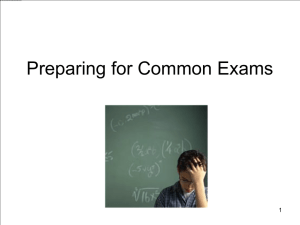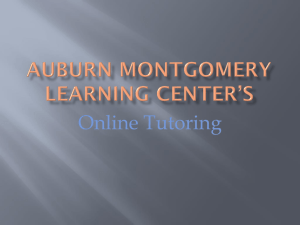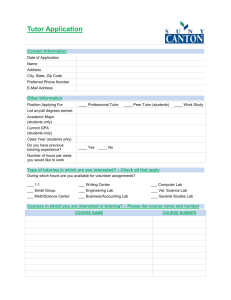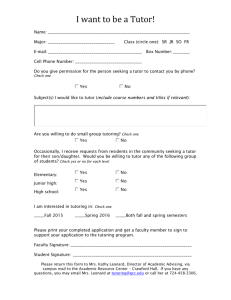APLNG 493 tutoring reflection paper
advertisement
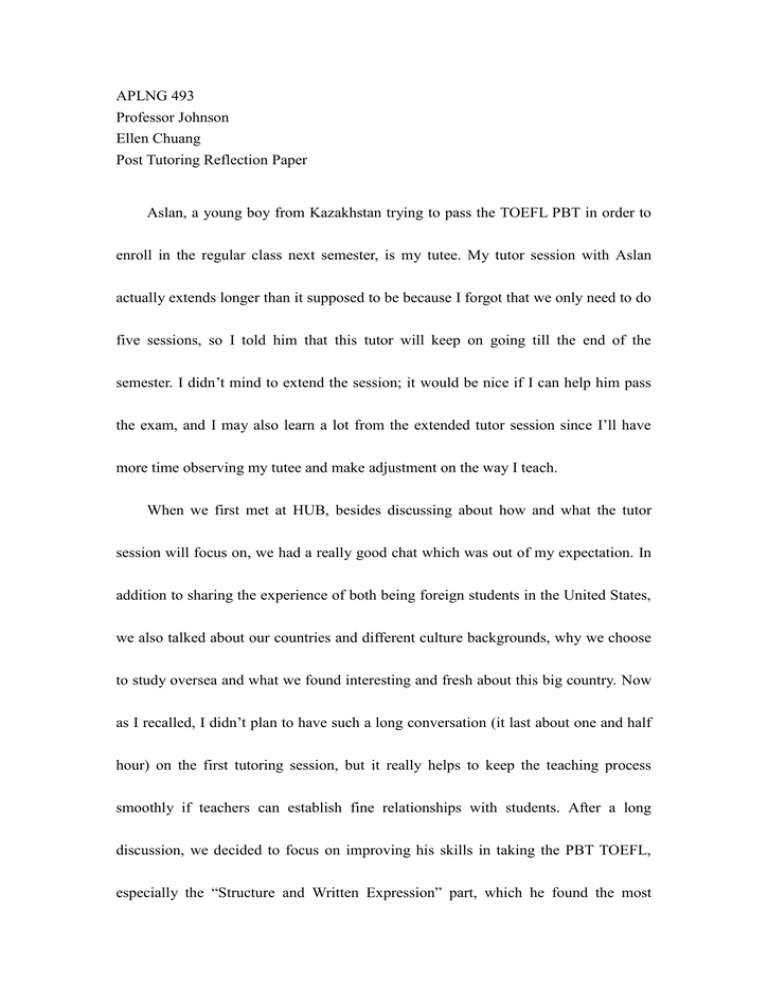
APLNG 493 Professor Johnson Ellen Chuang Post Tutoring Reflection Paper Aslan, a young boy from Kazakhstan trying to pass the TOEFL PBT in order to enroll in the regular class next semester, is my tutee. My tutor session with Aslan actually extends longer than it supposed to be because I forgot that we only need to do five sessions, so I told him that this tutor will keep on going till the end of the semester. I didn’t mind to extend the session; it would be nice if I can help him pass the exam, and I may also learn a lot from the extended tutor session since I’ll have more time observing my tutee and make adjustment on the way I teach. When we first met at HUB, besides discussing about how and what the tutor session will focus on, we had a really good chat which was out of my expectation. In addition to sharing the experience of both being foreign students in the United States, we also talked about our countries and different culture backgrounds, why we choose to study oversea and what we found interesting and fresh about this big country. Now as I recalled, I didn’t plan to have such a long conversation (it last about one and half hour) on the first tutoring session, but it really helps to keep the teaching process smoothly if teachers can establish fine relationships with students. After a long discussion, we decided to focus on improving his skills in taking the PBT TOEFL, especially the “Structure and Written Expression” part, which he found the most difficult. As per we had discussed, I tried to find some practice tests for him; he would complete one or two tests before the tutor session, and I would explain and clarify the questions or answers that confused him. I remembered that after the first session, I went home and started to google PBT practice tests, I also tried to answer some of the questions in the “Structure and Written Expression” part; surprisingly, it was not as easy as I thought, and some of them took me a while to figure out the answer. I felt a little bit panic at that time. I was nervous about being unable to clear all his doubts and how that might stuck myself in a very embarrassing situation, but our second session went pretty well, which again surprised me. As I had foreseen, some questions really struck me that I couldn’t provide answers with certainty, so I just told him that I also had doubts in the questions, and I’ll go back and check with classmates and teachers, or check online. He gladly accepted. It was such a relief to me. Probably due to my personality, I was so afraid to make mistakes and feel embarrassed for that, thus, I always got panic when I felt that something is out of my control and I couldn’t make it perfect. Before tutoring, I thought of every possibility that might lead me to that unbearable embarrassment, which made me even more anxious. However, after tutoring in the past a few weeks, I realize that things are not always that terrible, and I should really quit the habit of worrying too much. Therefore, another important thing I learned from tutoring is, a teacher must have confidence in himself/herself, and teach with a positive attitude. Consider the possible challenges or obstacles one might face during teaching and think of solutions, but not to gloom over them in advance. This might not be a big problem for many others, but it is really important to me. I really appreciate that my tutee’s friendliness builds up my confidence, and that the tutor session gives me an opportunity to brainstorm how to deal with unexpected problems. While celebrating my own development as a more confident tutor, it is more exhilarating that my tutee made tremendous progress in identifying the correct answers of the “Structure and Written Expression” part. At the beginning, he could barely get any answers right, and when I asked why he picked that one, he just shook his head and replying that he didn’t know. As a result, I decided to do the practice test with him once or twice a week (we had three sessions a week). We answered the questions one by one together, and I gave him an explanation instantly whether he answered it correctly or incorrectly. It took a lot of time in doing this, but later it was proved to be useful. Now Aslan could answer more than half of the questions correctly, and even if he got the wrong answers, he would tell me why he chose that answer or how the other choices confused him. Sometimes he was even able to identify why A is the right answer, not B, C, or D before I started to clarify for him. In order to provide instant explanation, I did many PBT practice tests myself, and I recognized several grammatical structures or rules that often showed in the prompts including the parallelism, singular and plural forms, infinitive, and appositive …etc. Whenever facing prompts that contain these rules, I used the metalanguage in my illustration. One reason for doing this is, I guess he might have heard of these linguistic terms, but he was just unfamiliar with how they really works; I can connect his own knowledge with the information just introduced, and this may enhance his impression on the grammatical rules and structures. Another reason is, with the metalanguage, he could search for more information on his own at home. Even though I tried to make my clarification as comprehensible as possible, it is also understandable that sometimes he couldn’t grasp the idea right away. Therefore, I usually encourage him to also search for certain information on his own, or, I would show him the website and talk about some important points listed on the page, and tell him that if he had time, he could look them up by himself. I remember Professor Johnson had talked about that it is even better to “teach on” the students rather than “teaching for” them, and I think that encouraging my tutee to do self research is one of the methods to teach on the student. Teachers don’t have to teach their students everything, or, it might be more appropriate to say that it’s impossible to teach them everything. Consequently, leaving room for students to figure out what they really want to know is a more effective way of teaching instead of spending a lot of time stuffing them with things they are not interested in. This is not to say that teachers only need to teach students things they’re interested in, but to create more flexibility for instructing. It works extremely well in my tutor session. As mentioned at the beginning, the tutor session will continue till the end of this semester, so I could only present the reflection based on the sessions that we went through so far. It’s a pity that I can’t share the final result if he had successfully gotten the score required by the department he intended to enroll in, however, I believe that he can certainly make it. One last thing that I learned from the tutor session is, to be positive to and have faith in the student. When they did something well, compliment them appropriately; when they fail to achieve something, encourage them not to quit. Even though I don’t have very specific course schedule for the tutoring, my course objective is very clear, to help Aslan score at least 550 in the TOEFL PBT to meet the department requirement. I believe that we can reach this goal together.



